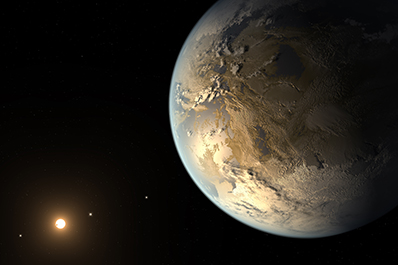
Leading the Search for other Earths
Pioneering Exoplanet Discoveries
The K2/Kepler mission is changing the way we look at our universe. Launched in March 2009, Kepler set out on an exoplanet-hunting mission to help us answer the centuries-old question, Are we alone? By surveying more than 150,000 stars in one region of our Milky Way galaxy and looking for slight dips in light observed when a planet passes in front of its star during its orbit, Kepler has discovered:
- Over 3,600 planetary candidates
- Over 700 multi-planet systems
- The first small planet in the habitable zone (Kepler—22b)
- Three Earth-sized planets in the habitable zones around their stars
- The smallest exoplanets ever detected (KOI-961.01, KOO-961.02, KOI-961.03)
- Five worlds that orbit around two stars, establishing a new class of planetary system
NASA Kepler Website
Click this link to learn more about the Kepler/K2 mission on the NASA website.

The K2 Mission
Kepler's Second Light
After completing its primary mission, Kepler’s operations were suspended due to a reaction wheel failure, but that didn’t stop Kepler. Our engineers and the rest of the Kepler team developed a new mission for the Kepler spacecraft, dubbed K2. The mission uses an innovative way to control pointing in the spacecraft by managing solar pressure and using thrusters. The K2 mission provides an opportunity to continue Kepler’s ground-breaking discoveries in the field of exoplanets and expand its role into new astrophysical observations.
K2 will perform a series of 80-day campaigns to conduct research into planet formation, young stars, stellar structure, evolution and extragalactic science. It will observe tens of thousands of stars per campaign and will transmit science data to the ground once every 80 days. K2 will search for new planets around bright stars and habitable worlds around M class stars to help pave the way for future missions like the James Webb Space Telescope.
In 2018, the Flight Planning Center at Ball Aerospace received a NASA Group Achievement Award for the execution of this innovative solution. The team's work enabled the Kepler spacecraft to return valuable scientific data long after its projected mission lifetime.
K2 will perform a series of 80-day campaigns to conduct research into planet formation, young stars, stellar structure, evolution and extragalactic science. It will observe tens of thousands of stars per campaign and will transmit science data to the ground once every 80 days. K2 will search for new planets around bright stars and habitable worlds around M class stars to help pave the way for future missions like the James Webb Space Telescope.
In 2018, the Flight Planning Center at Ball Aerospace received a NASA Group Achievement Award for the execution of this innovative solution. The team's work enabled the Kepler spacecraft to return valuable scientific data long after its projected mission lifetime.

What We Did
Mission Prime Contractor, Spacecraft & Instrument Provider, Integration & Test Lead
As mission prime contractor, we built the spacecraft and photometer and were responsible for system integration, testing and on-orbit operations.
In 2014, we were recognized for our role in confirming the age-old hope that planets and planetary systems are ubiquitous in the universe. The Kepler Mission Team was awarded the Smithsonian’s National Air and Space Museum Trophy for aerospace science and technology.
In 2014, we were recognized for our role in confirming the age-old hope that planets and planetary systems are ubiquitous in the universe. The Kepler Mission Team was awarded the Smithsonian’s National Air and Space Museum Trophy for aerospace science and technology.
The team responsible for the Kepler spacecraft has revolutionized humanity’s view of Earth’s place in the universe by discovering that planets are common throughout the Milky Way galaxy. As a result of Kepler’s discoveries, scientists are confident that Earth’s galaxy hosts tens of billions of Earth-sized planets that could reside in the temperate “habitable zone” of their parent star. Since its launch in 2009, Kepler has continued to make important scientific discoveries that will forever change humanity’s perception of its place in the cosmos. It also is establishing a foundation for future studies of exoplanet atmospheres that could eventually answer the question of whether or not humans are alone in the universe.
Spacecraft & Space Science
Learn more about how we make pioneering missions possible.
Instruments & Sensors
Sophisticated instruments deliver some of the world's most accurate data
Testing
Our hardware is qualified in state of the art environmental test facilities
